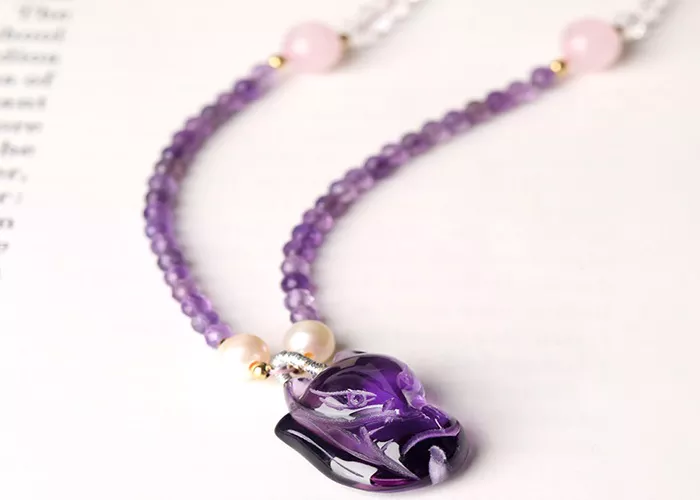The Edwardian period (1901–1914) and the Art Deco era (1920s–1930s) represent two pivotal moments in jewelry history, each reflecting profound shifts in aesthetics, technology, and societal values. Amethyst, a gemstone long associated with royalty and spirituality, was a favored material in both eras, yet its use in necklace designs diverged dramatically between these two periods. This article explores the key differences in amethyst necklace designs during the Edwardian and Art Deco periods, examining materials, craftsmanship, motifs, and cultural influences.
Historical Context and Cultural Influences
Edwardian Era: The Twilight of Opulence
The Edwardian period emerged in the wake of the Industrial Revolution but retained a strong connection to 19th-century aristocratic traditions. Named after King Edward VII, this era was characterized by a fascination with lightness, femininity, and intricate craftsmanship. Jewelry design drew inspiration from nature, Rococo revivalism, and the delicate aesthetics of the Belle Époque. Amethyst, with its regal purple hues, symbolized nobility and piety, often paired with diamonds and pearls to evoke ethereal elegance.
Art Deco Era: The Dawn of Modernity
The Art Deco period arose after the devastation of World War I, embodying a radical break from the past. It embraced machine-age innovation, geometric abstraction, and a globalized worldview influenced by Egyptian archaeology, Cubism, and the avant-garde. Amethyst necklaces from this era reflected a fascination with bold contrasts, streamlined forms, and exoticism. The gemstone’s rich color was now juxtaposed with materials like onyx, coral, or enamel to create striking visual statements.
Materials and Metalwork
Edwardian: Platinum Lace and Delicate Filigree
Platinum Settings: Delicate openwork resembling lace or cobwebs, with milgrain edges for added texture.
Diamond Accents: Amethysts were frequently surrounded by old-cut diamonds to enhance their luminosity.
Pearl Embellishments: Baroque pearls or seed pearls were used as pendants or connectors, softening the overall design.
These necklaces emphasized lightness and movement, with motifs like garlands, bows, and floral sprays dominating the compositions.
Art Deco: Geometric Boldness and Mixed Media
White Gold and Platinum: Polished metals with sharp, mirror-like finishes replaced ornate filigree.
Contrasting Gemstones: Amethysts were paired with black onyx, coral, or jade to emphasize color blocking.
Enamel and Lacquer: Vibrant enameling added graphic patterns, such as zigzags or sunbursts, to necklace settings.
Art Deco necklaces often featured symmetrical geometric arrangements, with amethysts cut into calibrated shapes (e.g., squares, triangles) to fit modular designs.
Symbolism
Edwardian: Romantic Naturalism
Edwardian amethyst necklaces celebrated organic forms and sentimental symbolism:
Floral and Garland Motifs: Vines, leaves, and blossoms were rendered in platinum, framing amethysts as “fruits” or floral centers.
Celestial Imagery: Moon and star motifs alluded to mysticism, aligning with the era’s interest in spirituality.
Locket Integration: Some necklaces included hidden compartments for keepsakes, reflecting the Victorian legacy of sentimental jewelry.
Art Deco: Abstraction and Exoticism
Art Deco designs embraced abstraction and global influences:
Egyptian Revival: Scarabs, lotus flowers, and stepped pyramids appeared in amethyst necklaces after Tutankhamun’s tomb discovery in 1922.
Cubist Geometry: Chevrons, sunbursts, and parallel lines created dynamic, machine-like precision.
Asian and African Motifs: Stylized pagodas, fans, or tribal patterns reflected Europe’s fascination with non-Western cultures.
Gemstone Cutting and Setting Styles
Edwardian: Soft Curves and Cabochon Cuts
Edwardian amethysts were often cut en cabochon (smooth, rounded) or as oval faceted stones to maximize their velvety color. Settings aimed to enhance the gem’s natural glow:
Cluster Settings: Amethysts were grouped in floral clusters, surrounded by diamond accents.
Swivel Bails: Pendants were designed to move freely, catching light from multiple angles.
Art Deco: Precision and Angularity
Art Deco favored sharp, calibrated cuts to fit geometric designs:
Step Cuts and Baguettes: Rectangular or trapezoidal amethysts were arranged in linear patterns.
Pavé and Channel Settings: Small amethysts were set flush with metal to form uninterrupted lines or borders.
Contrasting Sizes: Large central amethysts were flanked by smaller stones in symmetrical layouts.
Societal Shifts and Wearability
Edwardian: Aristocratic Refinement
Edwardian necklaces were worn primarilyby the elite for formal occasions. Designs emphasized grace and modesty:
Sautoir Necklaces: Long pearl-and-amethyst chains with tasseled ends were draped over gowns.
High Collar Settings: Shorter necklaces complemented high-necked Edwardian fashions.
Art Deco: Liberation and Versatility
The Art Deco era saw jewelry become accessible to the burgeoning middle class. Necklaces were versatile and bold:
Tiered Strands: Multiple strands of amethysts and onyx beads layered for dramatic effect.
Convertible Designs: Detachable pendants allowed necklaces to adapt to daytime or evening wear.
Cocktail Jewelry: Oversized amethyst pendants became staples of 1920s “flapper” fashion.
Legacy and Collectibility
Edwardian amethyst necklaces are prized for their craftsmanship and historical ties to European aristocracy. Their delicate designs require careful preservation, making intact pieces rare and highly collectible. In contrast, Art Deco amethyst necklaces appeal to modernists for their bold aesthetics and wearability. Pieces with Egyptian motifs or exceptional color contrast command premium prices at auctions.
Conclusion
The transition from Edwardian to Art Deco amethyst necklaces mirrors the broader cultural journey from tradition to modernity. Edwardian designs whisper of a vanishing world of handcrafted luxury, while Art Deco pieces shout the confidence of a machine-driven age. For collectors, understanding these differences not only aids in authentication but also deepens appreciation for how a single gemstone can embody the spirit of an era.
Related topics:
What Do Emerald – Cut Amethyst Necklaces Symbolize?
What Symbolizes Wearing an Emerald – Cut Amethyst Necklace?
Rock or Mineral? A Jeweler’s Deep Dive


